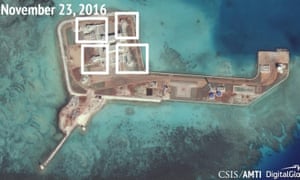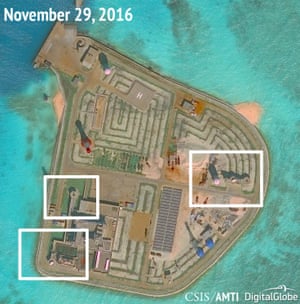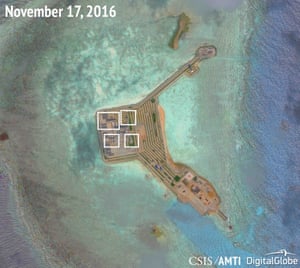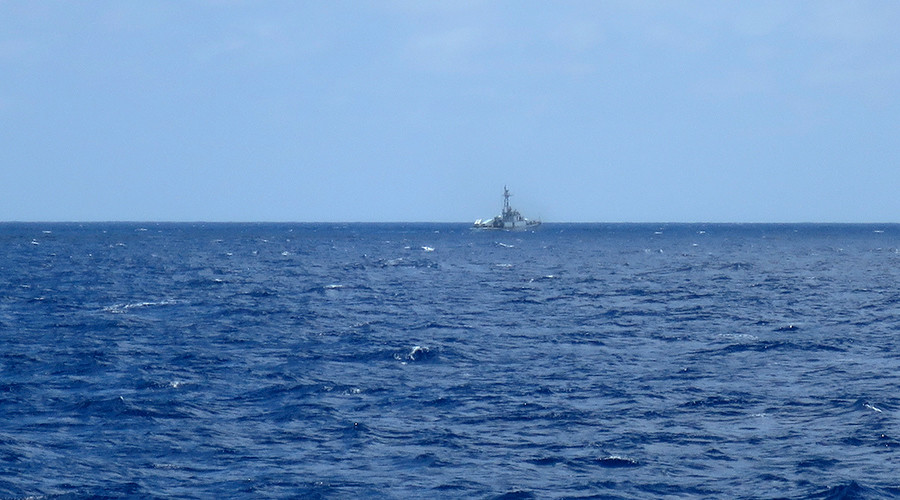China consolidates its positions in the South China Sea
By Henri Kenhmann 24 November 2016
A new hospital, three 3,000-meter-long airstrips, five lighthouses, 100% 4G telecommunication coverage, farms, desalination plants and solar power plants - China has invested tens of billions of yuan In recent years to extend its basic infrastructure on the distant islands in the Spratly Islands(Nansha Islands 南沙群岛)and consolidate its multiple positions in the South China Sea.
Since July, a class 2A hospital with more than 100 beds and an area of 16,000 m² is inaugurated on the "reef" of Fiery Cross(Yongshu Island 永暑岛), the 3rd largest island of Spratly that spans 2.8 km², largely due to backfilling.
Work began in November 2015 and was completed in just 8 months. A medical team of about fifty people ensures the proper functioning of the hospital. It has already welcomed more than 1,000 patients and has carried out a hundred operations so far.
The Fiery Cross (Yongshu) Hospital in the South China
In March, a Chinese naval patrol aircraft had to interrupt its current mission and land on Fiery Cross Island (Yongshu Island 永暑岛)in an emergency to repatriate a soldier who had fallen very ill on a Chinese island.
The commissioning of this hospital will greatly alleviate the pressure in medical support in this remote region of the world - whether for garrison soldiers based on the various islands controlled by China, or civilians who continue on-site work - where the nearest corner of the Chinese mainland is more than 1,000 kilometers away.
The interior of the establishment, rather well equipped with a structure of this size, is revealed in a CCTV report:
And there is no doubt that the presence of a medical infrastructure in this part of the South China Sea will give a significant tactical advantage to the Chinese army in times of war and conflict.
In addition to the hospital, five lighthouses were also inaugurated on the five largest Chinese islets in the Spratly Islands (Nansha Islands 南沙群岛): Subi (Zhubi 渚碧), Mischief (Meiji 美济), Fiery Cross (Yongshu 永暑), Johnson South (Chigua 赤瓜) and Cuarteron (Huayang 华阳). All of these islands have been artificially enlarged.
According to Chinese media, these lighthouses are more than 50 meters high and have a range of 20 nautical miles (around 37 km). They are all equipped with the AIS (Automatic Identification Systems) to track the position of the ships that crisscross the area.
Lighthouse at Mischief Reef (Meiji Reef 美济礁)
Lighthouse at Cuarteron Reef (Huayang Reef 华阳礁)
Lighthouse at Fiery Cross Reef (Yongshu Island 永暑岛)
Lighthouse at Johnson South Reef (Chigua Reef 赤瓜礁)
Lighthouse at Subi Reef (Zhubi Reef 渚碧礁)
Alongside its maritime utilities, these lighthouses are also an important psychological symbol to remind passers-by of the permanent presence of the Chinese in this highly strategic maritime passage.
The location of the main Chinese islets in the Spratly Islands (Nansha Islands 南沙群岛)
After medical care and aid to navigation, another much more vital element that is water demanded much more works from the Chinese. With more than 20,000 people at the peak of the backfilling, spread over the various islets in the Spratly (Nansha), fresh water has always been a problem, due in part to the fact that practically no Chinese islands in the South China Sea has any underground water source.
To remedy this situation, the Chinese have put in place several solutions. In addition to regular supplies from the mainland, rainwater harvesting and the recycling of used water are also the main sources for sanitary and construction needs.
Since 2013, the Chinese state has gradually put into operation desalination plants on all the islands, with capacity ranging from a few tons to a few thousand tons per day depending on the size of the block and the number inhabitants.
We already said, for example, one of these desalination plants installed on Woody Island (Yongxing Island 永兴岛) - the largest city and military base in the Paracel Islands (Xisha Islands 西沙群岛) - in our article "New desalination plant on the Woody (Yongxing) Island".
With freshwater pressure being greatly reduced, the Chinese now want to go further and are working hard to "recreate" a green ecosystem on its islands in the South China Sea, despite they're originally desert.
On the Subi Reef (Zhubi Reef 渚碧礁) for example, more than one million plants of various types, selected carefully by the Chinese Academy of Sciences, were transferred to the site to fix the sand and reduce its expansion. And on the other hand, also provide food to "local animals" and attract birds.
The objective is to create a suitable place for a sustainable settlement.
CCTV's report shows that these islands, although partly artificially created, are perhaps the most ecological place in China - all potentially toxic emissions are placed under control and all waste is recycled to the maximum - this proves that when human can not do otherwise, ecology is no longer just a slogan but an obligation for survival. It is therefore possible that this consciousness comes "naturally".
As for the long runways and landing, the cover of the telecommunications network, we already addressed these points last few months ago in our articles about "China is testing two airfields in the South China Sea " and "The Chinese 4G network covers the Spratly (Nansha) Islands ".
With these works that can be considered "fundamentals", the Chinese are imposing their will on a small fire in this part of the South China Sea, without even the need to raid militarily those islands that are already controlled by neighboring countries.
In the Spratly (Nansha) Islands, Vietnam and Malaysia are the two countries that control the most reefs, but those recovered by the Chinese nearly 40 years ago are geologically and geographically the most interesting. The orientation and composition of Chinese atolls have greater potential for future development.
It should be noted that this very progressive but above all very costly method applied by the Chinese in the South China Sea will still have a lasting and destructive effect for the other neighboring countries because it is not only difficult to duplicate but is also difficult to counter on the duration, less to relying prematurely on military operations, which unfortunately will have an uncontrollable and unbearable consequence.
And, paradoxically, this method is still more "constructive" than sending few warships to defend the "freedom of navigation" that has never been violated by any of the countries concerned.
When works on the islets of the Spratly (Nansha) Islands are completed, it is more than probable that the Chinese will do the same on the Scarborough Reef (Huangyan Island 黄岩岛), which is less than 300 kilometers from the Philippine coasts, and especially from the old Subic Bay naval base, which was more or less the largest overseas military installation for the United States military.
A case to follow.
Henri K.
A loose translation from the original article written in French by Henri Kenhmann from below link.
http://www.eastpendulum.com/chine-consolide-positions-mer-de-chine-meridionale
@hk299792458
Note: The addition of Chinese geographic names and some bold amplification are done by myself.



































